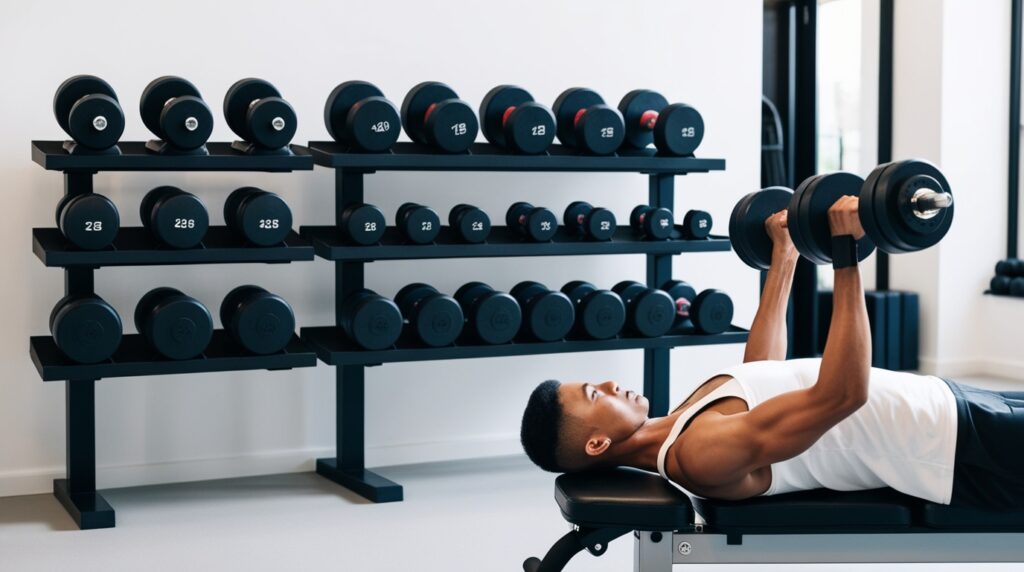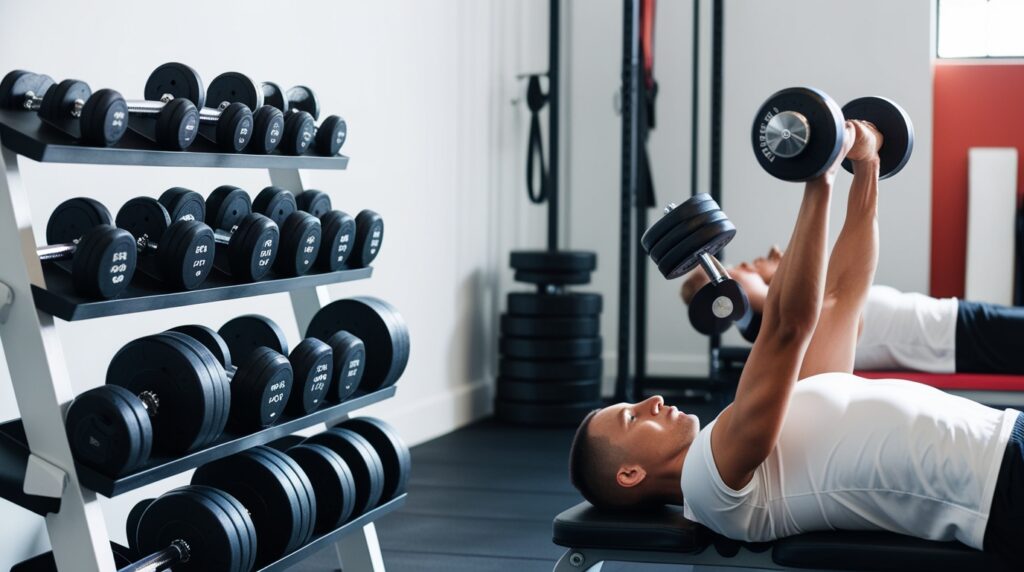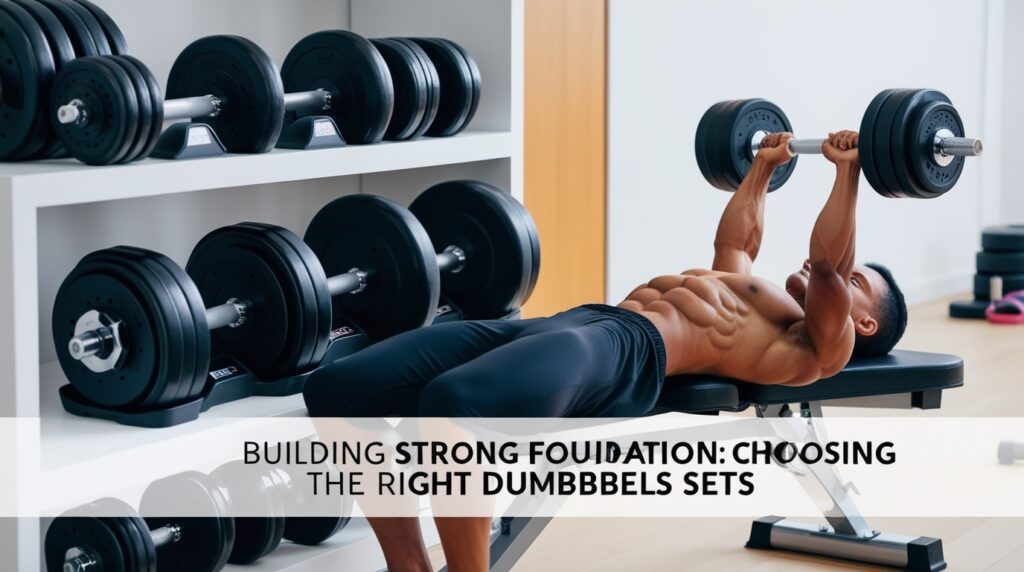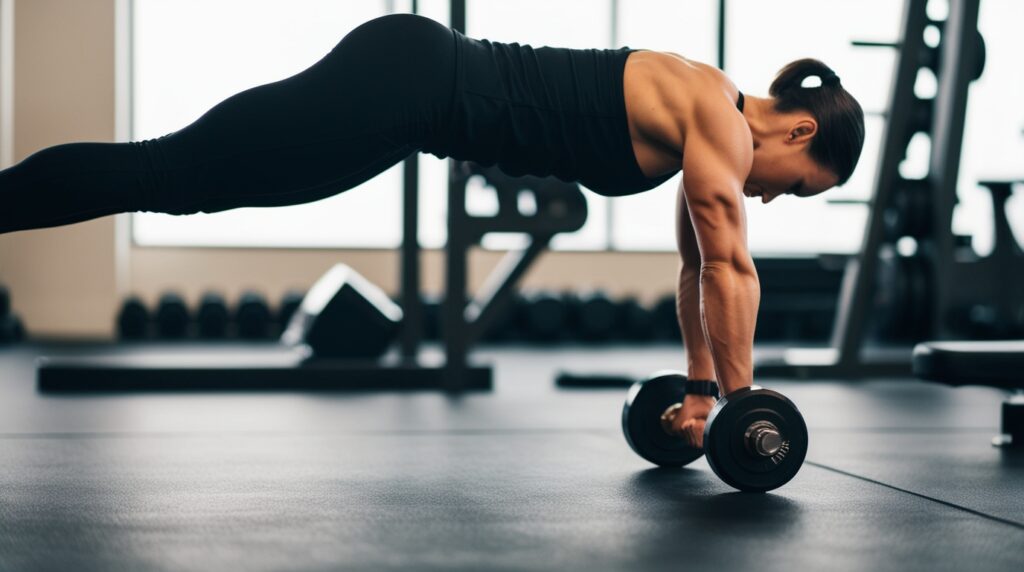Dumbbells are one of the most versatile pieces of equipment you can add to your fitness routine. Whether you’re a beginner or a seasoned gym-goer, dumbbell exercises offer the ability to target multiple muscle groups, build strength, and increase overall endurance. Unlike machines that restrict movement to a specific range of motion, dumbbells allow you to move freely, engaging stabilizer muscles and enhancing functional fitness. This article will explore the best dumbbell exercises for full-body strength, focusing on how to build strength in your back, chest, shoulders, core, and more.

Table of Contents
dumbbell Exercises
1. Strengthen Your Back with the Dumbbell Row
The dumbbell row is a fundamental movement that targets the muscles of your upper back, lats, and shoulders. It also engages your core as you work to maintain balance and stability throughout the exercise. Strengthening your back muscles is crucial for improving posture, preventing injury, and balancing out the work done by your chest muscles.

How to Perform a Dumbbell Row:
- Start by selecting a set of dumbbells with a manageable weight. You want to be able to perform the movement with good form but still challenge your muscles.
- Stand with your feet shoulder-width apart and hold a dumbbell in each hand. Bend slightly at the knees, and hinge at the hips so your torso is leaning forward. Keep your back flat and your core engaged.
- Let the dumbbells hang down in front of you, palms facing inward (neutral grip).
- Pull the dumbbells toward your torso by bending your elbows and squeezing your shoulder blades together. Focus on using your back muscles to lift the weights, not your arms.
- Lower the weights slowly back to the starting position, maintaining control throughout the movement.
- Perform 3 sets of 10-12 repetitions.
Benefits of the Dumbbell Row:
- Builds a strong, well-rounded back.
- Enhances posture and helps counteract the effects of sitting for long periods.
- Improves upper body strength and stability, making it easier to perform other compound movements like the deadlift and pull-up.
Incorporating dumbbell rows into your routine will not only give you a more sculpted back but also contribute to overall strength and endurance. A strong back is essential for balance, injury prevention, and daily activities like lifting and pulling.
2. Building a Strong Foundation: Choosing the Right Dumbbell Set
Before diving into your workout, it’s crucial to choose the right dumbbell sets for your fitness goals and experience level. Dumbbells come in a variety of shapes, sizes, and materials, and selecting the correct set can make or break your training experience.

Types of Dumbbell Sets:
- Fixed Dumbbells: These are your standard dumbbells, with a set weight that cannot be adjusted. Fixed dumbbells are commonly found in gyms and come in a range of weights, typically from 5 lbs to 100 lbs or more. They are durable and easy to use, but purchasing a full set for home use can be expensive and space-consuming.
- Adjustable Dumbbells: If you’re training at home or have limited space, adjustable dumbbells are a fantastic option. These allow you to adjust the weight by adding or removing plates, or by using a dial system that changes the weight in seconds. Adjustable dumbbells are cost-effective and space-saving, making them a popular choice for home gym enthusiasts.
- Rubber-Coated Dumbbells: These dumbbells are covered in rubber, making them less likely to damage floors if dropped. They are great for home workouts where safety is a priority.
How to Choose the Right Dumbbell Set:
- Experience Level: If you’re a beginner, start with lighter weights to ensure proper form before progressing to heavier dumbbells. Fixed dumbbells in the 5-20 lb range are ideal for beginners.
- Training Goals: If you’re focused on building muscle, you’ll need a wider range of weights to ensure progressive overload. Adjustable dumbbells are perfect for this, as you can gradually increase the resistance without needing to purchase additional sets.
- Space and Budget: Fixed dumbbells take up more space and can be more expensive in the long run, while adjustable dumbbells are more compact and budget-friendly. Consider these factors when setting up your workout area.
A solid set of dumbbells will serve as the foundation of your strength training routine. Investing in the right set will allow you to grow with your training and hit your fitness goals efficiently.
3. Boost Chest and Shoulder Power with the Dumbbell Press
The dumbbell press is a classic exercise for building strength in the chest, shoulders, and triceps. Unlike a barbell bench press, the dumbbell press allows for a greater range of motion and can help correct imbalances between the left and right sides of your body. Additionally, the dumbbells force your stabilizer muscles to work harder to control the weights, adding another layer of strength development to the exercise.

How to Perform a Dumbbell Press:
- Lie flat on a bench with your feet firmly planted on the floor. Hold a dumbbell in each hand at chest level, with your elbows bent at a 90-degree angle.
- Press the dumbbells straight up toward the ceiling, fully extending your arms. Make sure to keep your wrists in a neutral position and avoid locking your elbows at the top of the movement.
- Slowly lower the dumbbells back down to chest level, maintaining control and keeping your shoulder blades pinned to the bench.
- Perform 3 sets of 8-10 repetitions.
Variations of the Dumbbell Press:
- Incline Dumbbell Press: This variation targets the upper part of your chest and shoulders. Simply adjust the bench to a 30-45 degree angle to shift the focus of the exercise.
- Decline Dumbbell Press: By lowering the bench angle, you can place more emphasis on the lower portion of your chest.
Benefits of the Dumbbell Press:
- Builds a strong, defined chest and shoulders.
- Improves overall pressing strength, which is essential for pushing movements in daily life.
- Engages the stabilizer muscles in the shoulders and core, enhancing balance and coordination.
Whether you’re aiming to build muscle, improve endurance, or just increase overall strength, the dumbbell press is an essential part of any full-body workout routine. Incorporating both flat and incline variations can help you achieve a well-rounded, balanced upper body.
4. Engage Your Core and Upper Body with the Dumbell Workout
The dumbbell pullover is an underrated yet highly effective exercise that targets both the upper body and the core. This movement primarily works the chest, lats, and shoulders, while also engaging the triceps and core stabilizers. It’s a great way to build upper-body strength and improve flexibility in the shoulders.

How to Perform a Dumbbell Pullover:
- Lie on a bench with your upper back and shoulders supported, feet flat on the floor, and your hips slightly raised. Hold a dumbbell with both hands above your chest.
- Keeping your arms straight but with a slight bend in the elbows, slowly lower the dumbbell behind your head in an arc-like motion. Make sure to keep your core engaged to protect your lower back.
- Once the dumbbell reaches just below head level, pull it back up over your chest using your lats and chest muscles.
- Perform 3 sets of 10-12 repetitions.
Benefits of the Dumbbell Pullover:
- Targets the chest and lats simultaneously, making it a highly effective upper-body exercise.
- Improves shoulder mobility and flexibility, which can help prevent injuries.
- Engages the core muscles, enhancing overall stability and strength.
Dumbbell Pullover Variations:
- Bent-Arm Pullover: This variation puts more emphasis on the lats and less strain on the shoulders.
- Single Dumbbell Pullover: Instead of using both hands, try performing the pullover with one hand to increase the difficulty and engage more stabilizer muscles.
The dumbbell pullover is often overlooked, but it’s an excellent exercise for building upper-body strength while also improving core stability. It’s particularly effective for those looking to enhance their chest and back development in a single movement.
5. Sculpt Your Upper Body with a Chest Dumbbell Workout
A well-defined chest is often a hallmark of strength and fitness, and incorporating a chest dumbbell workout into your routine is one of the most effective ways to achieve this. Dumbbells allow for a greater range of motion compared to barbells, helping you target the chest muscles more thoroughly while also engaging stabilizing muscles in your shoulders and core.
Key Exercises for a Chest Dumbbell Workout:
- Flat Dumbbell Press:
The flat dumbbell press is a staple exercise for building chest strength. Lying flat on a bench, hold a dumbbell in each hand at chest level. Push the dumbbells up until your arms are fully extended, then lower them back down slowly. This exercise primarily targets the pectoral muscles but also works the triceps and shoulders. - Incline Dumbbell Press:
This variation focuses on the upper part of the chest, giving you a more defined upper body. Adjust the bench to a 30-45 degree angle, and perform the same pressing motion as the flat press. The incline helps isolate the upper pecs, creating a fuller, more muscular chest appearance. - Dumbbell Flyes:
To emphasize the stretch and contraction of the chest muscles, dumbbell flyes are ideal. Lying on a flat bench, hold the dumbbells above your chest with a slight bend in your elbows. Slowly open your arms, lowering the dumbbells to the sides until you feel a deep stretch in your chest. Bring them back to the starting position, squeezing your pecs at the top. Flyes work the inner chest and give your pecs a more sculpted look.
Benefits of a Chest Dumbbell Workout:
- Full Range of Motion: Dumbbells allow you to work through a greater range of motion compared to machines or barbells, leading to more muscle activation.
- Balanced Muscle Development: Since you’re using individual weights in each hand, dumbbell exercises can help correct strength imbalances between the left and right sides of your chest.
- Improved Shoulder Stability: Dumbbell chest exercises engage the stabilizer muscles in your shoulders, improving shoulder health and reducing the risk of injury.
Including a comprehensive chest dumbbell workout in your routine will not only improve your strength but also enhance the aesthetics of your upper body, giving you a strong, sculpted chest.
6. Tone Your Arms with an Effective Tricep Dumbbell Workout
While the biceps often get a lot of attention, the triceps are actually the larger muscle group in your arms, making up about two-thirds of your upper arm mass. A well-rounded tricep dumbbell workout can significantly improve the size, strength, and tone of your arms, giving them a more defined and powerful look.
Key Exercises for a Tricep Dumbbell Workout:
- Dumbbell Tricep Kickback:
This is a great isolation exercise that targets all three heads of the tricep muscle. To perform it, stand with a dumbbell in each hand and bend forward slightly at the waist. Keeping your upper arms stationary, extend your forearms behind you, squeezing your triceps at the top of the movement. Lower the weights slowly and repeat. - Overhead Dumbbell Tricep Extension:
The overhead tricep extension is another excellent move for targeting the long head of the tricep. Stand or sit with a single dumbbell held with both hands overhead. Lower the dumbbell behind your head by bending at the elbows, then extend your arms back to the starting position. This exercise provides a deep stretch and a strong contraction, which helps build size and strength in the triceps. - Close-Grip Dumbbell Press:
Similar to a chest press but with the dumbbells held close together, this exercise shifts more emphasis onto the triceps. Lying on a flat bench, press the dumbbells together and lower them to your chest. Press them back up, focusing on squeezing your triceps throughout the movement.
Benefits of a Tricep Dumbbell Workout:
- Bigger, More Defined Arms: Working the triceps helps increase the overall size of your arms, giving them a fuller, more muscular appearance.
- Improved Pushing Strength: Strong triceps are essential for pushing movements, which carry over into exercises like the bench press, push-ups, and even daily activities that require pushing force.
- Reduced Risk of Injury: Strengthening the triceps can improve the stability of your elbows and shoulders, reducing the risk of injury in other lifts.
Incorporating these exercises into your routine will ensure balanced arm development and help you build the strong, toned arms you desire.
7. Build a Strong Back with These Essential Dumbbell Exercises
Dumbbell Exercises are crucial for a strong back, overall strength, good posture, and functional movement. Whether you are lifting, pulling, or pushing, your back muscles play a central role in stabilizing your body and enabling you to perform daily tasks more efficiently. A comprehensive back dumbbell exercises focuses on the muscles of the upper, middle, and lower back, as well as the lats, traps, and rear delts.
Key Exercises for a Back Dumbbell exercises Workout:
- Dumbbell Row:
The dumbbell row is one of the most effective exercises for building a strong, muscular back. Standing with a dumbbell in each hand, hinge forward at the hips while keeping your back flat. Pull the dumbbells toward your torso by squeezing your shoulder blades together, then lower them back down. This exercise primarily targets the lats and rhomboids, but it also engages the traps and rear delts. - Dumbbell Deadlift:
Although often associated with barbells, the deadlift can be performed with dumbbells to effectively target the entire posterior chain, including the lower back, glutes, and hamstrings. Stand with your feet shoulder-width apart, holding a dumbbell in each hand. Keeping your back flat and knees slightly bent, lower the dumbbells toward the floor by hinging at the hips, then return to the standing position by driving through your heels. - Dumbbell Shrug:
To build strong traps, dumbbell shrugs are an excellent option. Stand upright with a dumbbell in each hand at your sides. Simply shrug your shoulders up toward your ears, hold for a second, and then lower them back down. This exercise isolates the trapezius muscles, adding thickness and strength to your upper back.
Benefits of a Back Dumbbell Workout:
- Improved Posture: Strengthening the muscles in your upper and lower back helps combat the effects of sitting for long periods and promotes better posture.
- Balanced Physique: A strong back ensures that your upper body strength is balanced, reducing the risk of muscle imbalances and injury.
- Enhanced Pulling Power: Back exercises improve your ability to pull objects, whether in the gym or in daily life, making tasks like lifting or carrying easier and safer.
By incorporating these back-focused dumbbell exercises into your routine, you’ll build a strong, functional back that supports overall strength and mobility.
8. Enhance Shoulder Strength and Stability with a Dumbbell Workout
Strong, well-developed shoulders are essential for upper-body strength, mobility, and aesthetics. A solid shoulder dumbbell exercises workout not only helps you build muscle in your deltoids but also improves the stability and health of your shoulder joints, which are crucial for a wide range of movements, from pushing and pulling to lifting and carrying.
Key Exercises for a Shoulder Dumbbell exercises Workout:
- Dumbbell exercises for Shoulder Press:
The shoulder press is a classic dumbbell exercises that builds strength in the front, side, and rear deltoids. Sit or stand with a dumbbell in each hand, held at shoulder height. Press the dumbbells overhead until your arms are fully extended, then lower them back down slowly. This exercise is great for building mass and strength in your shoulders. - Lateral Raise:
Lateral raises target the side deltoids, giving your shoulders a wider, more defined appearance. Stand with a dumbbell in each hand at your sides, palms facing inward. Raise your arms out to the sides until they are parallel to the floor, then lower them back down. Be sure to keep a slight bend in your elbows and avoid using momentum. - Rear Delt Fly:
The rear delt fly isolates the muscles in the back of your shoulders, which are often neglected but critical for balanced shoulder development. To perform this exercise, bend forward at the waist, holding a dumbbell in each hand. With a slight bend in your elbows, raise the dumbbells out to the sides until your arms are parallel to the floor, then lower them back down. This movement helps build a stronger upper back and improve shoulder stability.
Benefits of a Shoulder Dumbbell Exercises Workout:
- Improved Shoulder Stability: Dumbbell exercises require balance and coordination, which strengthens the stabilizer muscles around the shoulder joint, reducing the risk of injury.
- Increased Upper-Body Strength: Strong shoulders are essential for pushing and pressing movements, which carry over to exercises like the bench press, push-ups, and even overhead lifts.
- Better Aesthetics: Developing your shoulders gives your upper body a more rounded, muscular look, enhancing your overall physique.
By consistently incorporating these shoulder exercises into your workout routine, you’ll not only build strength but also improve your shoulder mobility and stability, ensuring a more well-rounded upper body.
Conclusion
Dumbbells are a powerful tool in the world of strength training, offering a wide range of exercises that target multiple muscle groups and enhance overall functional fitness. By incorporating movements like the dumbbell row, dumbbell press, and dumbbell pullover into your routine, you can build a strong, balanced body that’s resistant to injury and capable of handling various physical demands.
When paired with the right dumbbell sets, these exercises allow you to progressively challenge your muscles, ensuring continued growth and development. Whether you’re working out in a commercial gym or setting up your home gym, dumbbells offer an unmatched level of versatility, making them a must-have in any fitness arsenal.
Take your time to perfect your form, gradually increase your weight, and be consistent with your workouts. Over time, these dumbbell exercises will help you achieve the full-body strength you’re aiming for, all while improving your balance, coordination, and overall physical health.
